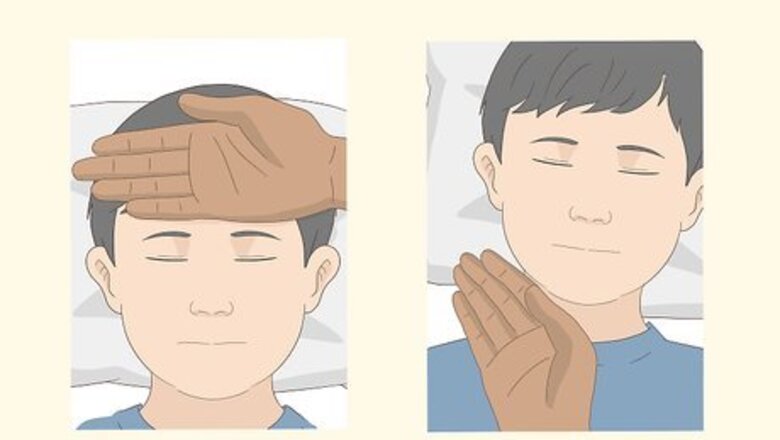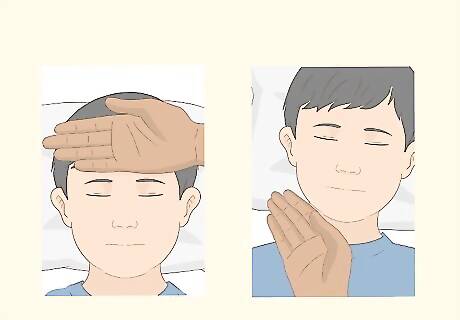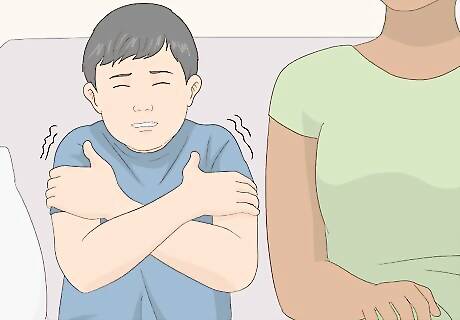
views
- Use the back of your hand to see if you or your loved one’s forehead is warm, as that’s a leading sign of a fever.
- Check to see if you or your loved one is sweating or shivering without cause—the body may be reacting to its internal temperature.
- Call a doctor if the fever persists for more than 3 days or worsens with time.
Warm forehead or neck

If someone has a fever, they’ll most likely be warm to the touch. Use the back of your hand to gently touch your or your loved one’s forehead and/or neck. Notice the environment around them to make sure they’re not feeling too warm because they’re under blankets or in a hot room. If something may be affecting their temperature, remove it and try again after 30 or so minutes. Avoid touching the hands and feet to check for a fever, as they can feel cold when body temperature rises or blood circulation is low. Some people may feel clammy or cool when they have a temperature. If something doesn’t feel normal, it’s probably because they’re sick. Use fever-reducing over-the-counter medications like Tylenol (acetaminophen) or Advil (ibuprofen) to calm a rising temperature.
Flushed cheeks

A high temperature usually causes a person’s face to turn red. When your body overheats, you’ll begin to look flushed, like you’ve just run a mile or done strenuous exercise. Look in a mirror or closely at your loved one’s face. If they appear redder than usual, they may have a fever. If you or your loved one have a dark skin tone, this may be more difficult to notice.
Chills and/or sweating

The body may involuntarily react to a fluctuating temperature. If someone has a fever, it’s very common for them to shake or sweat. No matter the room’s temperature or what they’re wearing, they’ll react to what they feel on the inside. Notice if you have the chills or feel more sweaty than normal, or watch your loved one closely. It’s normal to alternate between feeling cold and hot when you have a temperature. Change into lighter clothing and remove heavy blankets to help calm a fever.
Muscle aches

Changes in body temperature can make someone ache. If you or your loved one experience muscle or joint pain, it could be because of a fever. These pains could be sharp or steady, and may be a sign of a cold, the flu, or an infection. Take note if you feel abnormally sore, like you just worked out, or ask your loved one if any part of their body hurts. Rest, ice packs, warm baths, and over-the-counter pain medications (Tylenol and Advil) can help ease muscle aches when someone has a fever.
Fatigue

Fevers can make someone feel lethargic or extremely tired. Perhaps you or your loved one is having trouble staying awake and just wants to lie in bed. Slow movements, abnormal exhaustion, and slow speech could all be a sign of illness. If a child is sick, they’ll usually say they feel sleepy, rub their eyes more than usual, or throw tantrums. Resting can give the body energy to fight off a fever.
Headache

A fever can cause someone’s head to throb. More often than not, a fever is paired with a headache. If your loved one starts complaining of a headache or you start to feel one coming on, it may be because you’re starting to get sick. A pounding headache may be a sign of an infection or a common cold. Headaches alone can’t diagnose a fever or illness, but if someone has more than one symptom, it’s very likely that they have a high temperature. If you or your loved one have a headache, take some Tylenol, drink plenty of water, and rest to ease your symptoms.
Dark-colored urine
Dehydration can occur if you or a loved one has a fever. When you don’t feel well, skipping your normal glasses of water can be easy. Take a peak in the toilet after you pee, or ask your loved one not to flush once they’re done. If the urine is bright yellow or orange, someone could be dehydrated. If the urine is dark brown, contact your doctor immediately, as this could be a case of extreme dehydration or an underlying medical condition. If you or your loved one is experiencing this symptom, drink plenty of fluids to stay hydrated and reduce fever. Try sipping on soup, eating flavored gelatin, or sucking on ice pops or ice chips if drinking makes you or your loved one nauseous.
Loss of appetite

Food may be someone’s last thought if they have a fever. When you’re sick, sometimes the last thing you want to do is eat, especially if you’re feeling nauseous (which is also normal). Notice if you feel less hungry than normal or if your loved one is rejecting their favorite foods. Get plenty of rest and drink electrolyte fluids like Gatorade or Pedialyte.
When to See a Doctor

Seek medical attention if fever lasts longer than 3 days. Generally, fevers are nothing to be alarmed about—they’re a normal part of sickness. But if someone’s fever continues to spike or they experience additional symptoms like loss of appetite, severe headache, or vomiting, it may be a sign of infection or severe illness. Here’s when you should see a doctor depending on age: If an infant or toddler has a fever higher than 102 °F (39 °C) for more than a day. If a child over 2 years old is unresponsive, has a fever for more than 3 days, or has a seizure. If an adult has a temperature over 103 °F (39 °C) or has a stiff neck, difficulty breathing, or abdominal pain.

















Comments
0 comment